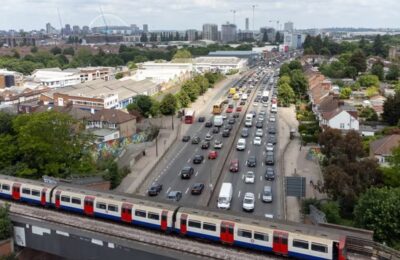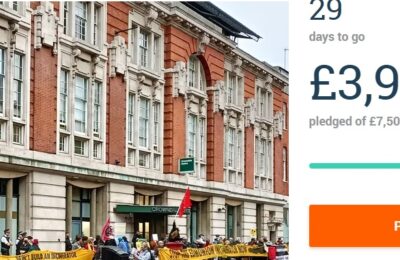Simon Pirani makes the case against the Silvertown Tunnel and argues that a campaign of civil disobedience is required.
As the UK prepares to host international climate negotiations in November, London’s local authority is pressing ahead with a £2 billion-plus climate-trashing tunnel project that is incompatible with decarbonisation.

The Greater London Authority’s Silvertown Tunnel, together with the government’s £27 billion motorway upgrade scheme, makes a mockery of the UK’s claim to be “leading the way” on tackling climate change.
The tunnel project also shows that climate hypocrisy is bipartisan: it’s the biggest spending decision this decade by Labour’s most powerful elected official, London mayor Sadiq Khan. Labour,
like the Tories, talks “green” – while piling up the most frightful problems for our grandchildren and great-grandchildren.
The tunnel is deeply unpopular locally. The long list of opponents includes four local Labour MPs, four Labour-controlled local councils, eight Constituency Labour parties and 20 Labour branches, the Greens and Liberal Democrats in London, dozens of community, trade union and environmental organisations, groups of doctors and teachers, and a long list of researchers of climate science, air pollution and transport policy.
The tunnel, a terrible idea long before Covid-19, looks even worse now: long-term transport projections are being rewritten and Transport for London desperately needs financial and management resources for other things. But the Mayor and other GLA officials have resisted calls for a review tooth-and-nail.
Download this whole article as a PDF here.
Here are six reasons why the tunnel destroys the GLA’s claim that it takes climate change seriously.
- Building the tunnel, even before a single vehicle went through it, would cause plenty of carbon dioxide emissions.
Transport for London has estimated that the concrete and other materials used to build the tunnel would have 82,077 tonnes of embedded CO2 (i.e. CO2 emitted during the manufacture of those materials). That’s roughly what a Boeing 737-400 would produce in 7000 trips of 900+ kilometres.
Another Transport for London report put the embedded CO2 at 108,961 tonnes, and emissions during construction (including the removal and transportation of 42.5 million tonnes of waste) at another 44,318 tonnes. (See endnote for sources.) But no complete life-cycle analysis has been done. And no account taken of the construction of auxiliary roads, lorry parks and other infrastructure.
Moreover, all these emissions would only be a small part of the tunnel’s climate impact. Far greater damage would be done by emissions from the extra traffic produced by the expansion of the road network.
- More roads produce more traffic – and this tunnel would too. And that would mean more CO2 emissions, when the climate emergency requires that they be cut, fast.
It’s not only common sense that building more roads produces more traffic, it has also been proven by decades of transport research, including reports commissioned by the UK government in 1994, 1998 and 2018.
The GLA claims, falsely, that a road toll on the Silvertown tunnel, and the Blackwall tunnel nearby, would prevent extra traffic. The Stop the Silvertown Tunnel Coalition has produced abundant evidence (e.g. in a recent letter and in this report) that it would not. A toll on the next crossing down the Thames, at Dartford, has not stopped traffic far exceeding the planned capacity.
What counts, after all, is not the number of cars using a particular stretch of road, but the inexorable increase in the number of cars – and in this case, HGVs – provided for by the inexorable expansion of the road network.
The modelling conducted for the tunnel project perversely minimised the induced traffic effect – in particular, by assuming that the total number of trips across the Thames would not be changed by a new tunnel. The Stop the Silvertown Tunnel coalition sounded the alarm on that, most recently, to the London Assembly oversight committee in February. (See 9 February letter here.) No answer from them, yet.
The GLA’s plans to tame traffic lag behind the UK government’s plans, which in turn lag behind what is needed, Jaise Kuriakose of the Tyndall Centre for Climate Change Research explained on a recent webinar about the tunnel. (Watch here, starting at 12 minutes).
The level of carbon emissions allowed in the GLA’s pathway “exceeds that in the UK government net-zero pathway, let alone a Paris-compliant target”, Kuriakose said.
“Lots of research shows that demand reduction – in this case, less transport – is important for near-term reductions in emissions, because the new technologies [e.g. electric vehicles] will take time to implement.”
Joanna Haigh, Distinguished Research Fellow at Imperial College London, also spoke at the webinar, pointing out that while UK emissions as a whole have fallen over the last 30 years, those from transport have gone up.
National and local governments are key determinants of whether people choose to drive or to use public transport, she said. “If government and local authorities make it easier for people to go on public transport, that is what they will do.”
- Underlying the transport problem is a climate policy problem. The GLA climate targets fall far short of what is needed to tackle dangerous global warming. While the climate emergency requires actions above and beyond those targets, the tunnel would go in the opposite direction.
The carbon budgets (i.e. the amounts of carbon that can be pumped into the atmosphere) that the GLA allows itself are far greater than the ones worked out by the Tyndall Centre, with a view to London contributing to the 1.5 degree target. The Tyndall calculations are part of a project to help UK local authorities with decarbonisation.
The yawning gap between what the Tyndall Centre scientists say is needed, and what the GLA is aiming at – in trajectories published in 2018, in the Zero Carbon London document – is shown on this graph, put together for the Stop the Silvertown Tunnel coalition.
The Tyndall Centre’s carbon budgets imply that emissions in London need to fall by about 12% per year during the 2020s. The GLA is only aiming at 5%.
The third, grey, line on the graph is perhaps the most frightening of all. It shows the operational assumptions about transport sector emissions that managers in Transport for London are working with.
They expect carbon emissions from transport to fall by less than one tenth between 2012 and 2036, whether or not the Silvertown tunnel is built. (The graph, as a downloadable file with full explanatory notes, is here.)
This suggests that not only are the GLA plans on emissions far behind what is necessary, but also that no effort has been made to reconcile those plans with what transport managers are doing on the ground.
Indeed the London Transport Strategy includes an incredibly unambitious target for reducing traffic: to cut the number of vehicle-kilometres driven in the capital by just 10-15% by 2040. How does that fit with cutting carbon emissions by 5% each year (as the GLA claims to want to do), let alone by 12% (as the Tyndall centre proposes)? No-one knows.
- This is not just about London. It’s part of a wider problem: the UK’s climate targets are a long way from what is needed.
When it comes to tackling dangerous global warming, and changing the transport system to do so, there is little difference between the Labour-controlled GLA and the Tory government. Both claim to lead the world on climate; both are investing heavily in carbon-intensive road networks.
London’s Silvertown project goes hand-in-hand with the government’s Road Investment Strategy, under which £27.4 billion will be spent on expanding the Strategic Roads Network. If this goes ahead, carbon emissions from the transport sector (currently 28% of the UK total) will most likely go up, in the next critical few years, when they need to fall sharply.
Transport for Quality of Life estimates that the investment programme “will make carbon emissions from the Strategic Roads Network go up, by about 20 million tonnes of CO2, during a period [2021-32] when we need to make them go down, by about 167 mt CO2”. The Transport Action Network is challenging the whole thing in court.
At UK level, as in London, the road-centred transport strategy – along with other relevant policies (energy sector, housing, and so on) – falls short of decarbonisation targets. At UK level, as in London, those targets themselves are way behind what climate scientists say needs to be done.
Scientists at the Tyndall centre last year published a key paper on how the UK’s and Sweden’s climate targets fall short, entitled A Factor of Two.
They argued that decarbonisation needs to move at least twice as fast as implied by the Climate Change Committee five-year carbon budgets – targets that the CCC says the government is, in any case, on course to miss.
The authoritative Climate Action Tracker team, who work the numbers out differently, also deem the UK’s targets, and current policies, as “inadequate” to meet the goal, mentioned in the 2015 Paris climate agreement, of limiting warming to 1.5 degrees above the pre-industrial level.
- The GLA and the UK government ignore scientists’ findings that existing fossil-fuel infrastructure (including roads and tunnels) endangers the goal of keeping global warming to 1.5 degrees above pre-industrial levels – a powerful reason not to build any more.
Emissions from existing fossil-fuel-burning infrastructure already “represent more than the entire [global] carbon budget that remains”, if warming is to be limited to 1.5 degrees, Dan Tong and his colleagues wrote in 2019.
They were following up on a pioneering paper by Steven Davis and colleagues, published in 2010, which estimated that the infrastructure that then existed was most likely correlated with a 1.3 degree temperature rise.
In the decade since that paper was written, the sale of fossil-fuelled cars has ballooned (in rich countries especially), along with air travel, coal-fired electricity generation and all the rest. The world’s fleet of SUVs has swelled from 50 million to more than 280 million.
Both of these research papers only surveyed devices that directly emit CO2: in the transport sector, that means cars, trucks and planes. But Davis and his colleagues highlighted the role of other “substantial” infrastructure that “produces and facilitates use of these devices”, for example “factories that produce internal combustion engines, highway networks dotted with gasoline refueling stations, and oil refineries all promote the continuation of oil-based road transport emissions”.
The highway networks and tunnels so fiercely championed by UK politicians could help to take global temperature soaring past the 1.5 degree level.
- Because climate science and transport research shouts “stop this tunnel” so loudly, the GLA have resorted to deception and distortion to justify the project.
Just as Tory cabinet ministers paved the way for mass coronavirus infections last year, while falsely claiming to “follow the science”, so both Tory and Labour politicians are adding to the global warming disaster while claiming to adhere to “Paris-compliant carbon targets”.
The London mayor, Sadiq Khan, claimed in a letter to anti-tunnel campaigners that London’s carbon reduction pathway is “in line with […] IPCC trajectories that are consistent with a limited probability of overshooting 1.5C warming”. (Details in the Stop Digging report, page 15.) The graph above shows that that is just not true.
When challenged on the detail by campaigners, London’s deputy mayor for transport, Heidi Alexander, has repeatedly claimed not only that the tunnel project is compatible with tackling climate change, but e.g. that it is essentially a public transport project, or that “the terms of the Development Consent Order ensure that traffic congestion and pollution wouldn’t get worse” if the tunnel was built. Campaigners have countered the tide of misinformation with fact sheets, available here and here.
In a recent letter to residents who oppose the tunnel, Alexander cynically compared the projected emissions from building it (about 153,000 tonnes of CO2, see point 1 above), with a possible future
reduction in emissions from electrifying London’s bus fleet (500,000 tonnes of CO2 per year). This is shameful obfuscation. Firstly, because the emissions from construction would be far smaller than those from extra traffic – which Alexander and her colleagues have stubbornly refused to quantify. Second, because potential future emission cuts from electrification are no substitute for urgent cuts needed in this decade. And third, because those cuts can be achieved without building any tunnels, and will no doubt be needed anyway to bridge London’s monstrous emissions gap.
As opposition to the tunnel has raged through the Labour party in London, Alexander has made an especially bizarre claim that the project has been “independently assessed” by the C40 alliance of city governments “to be in line with the advice of the Intergovernmental Panel on Climate Change on the level of carbon emission reduction required to put us on track to staying within 1.5degC global warming”.
C40 has actually done nothing of the sort. Rather, its chief executive, Mark Watts, sent a letter to mayor Khan, confirming that London’s climate policies conform with a check-list of C40 recommendations (the Climate Action Planning Framework (CAPF)).
I have sent a string of emails to Watts about this. The latest said: “Having studied the CAPF and associated documents, we [in the Stop the Silvertown Tunnel coalition] presume that its purpose was to give guidance to city administrations on how to step up their efforts to decarbonise. We presume the CAPF was not intended to be used by those administrations to justify carbon-heavy projects that will defeat the decarbonisation objectives set out in documents. But this is precisely how the GLA is using the CAPF.”
I’ve had no answer, from even the most menial flunky in the lavishly-funded C40 organisation. (If anyone there is reading this, please ask your boss to get in touch.)
Not only are leading Labour politicians in London trying to greenwash a climate-trashing road project, but they are also using C40 for the same purpose. They are corroding democracy, to defend the indefensible.
The conclusions are that, just as the political hostility to scientific research claimed tens of thousands of lives in the coronavirus pandemic last year, so the longer-term political resistance to the implications of climate science will produce damaging and dangerous results. The ruinous refusal to move away from fossil-fuel-heavy economic growth – and, in this case, car-based urban transport systems – takes longer than the denial of coronavirus science to work its way through to deaths and destruction, but it does do so.
Senior Labour politicians show the same willingness as the Tories to deceive and cheat, rather than abandon fossil-fuel-heavy policies. We will face a crescendo of this deception and cheating in the run-up to the climate talks in Glasgow in November, and we need to respond forcefully.
The GLA clearly has no social licence to go ahead with the Silvertown Tunnel, any more than the government has a social licence to start opening new coal mines. If ever there was a case for a campaign of civil disobedience, this is it.




